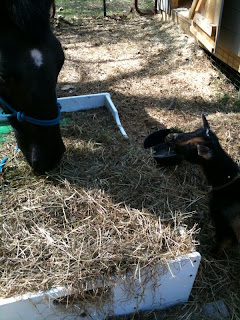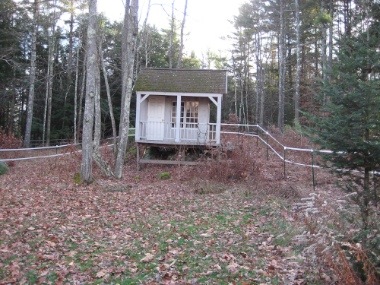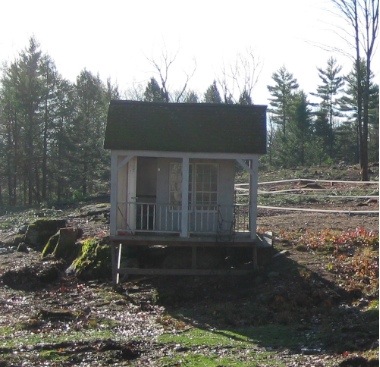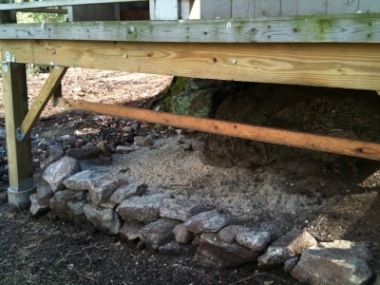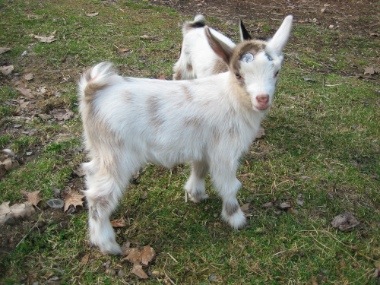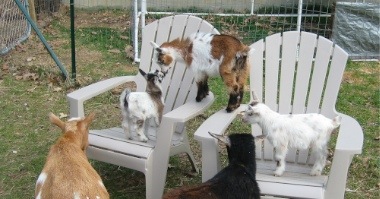The gentle prodding of a reader awoke me from my blogging slumber. I was amazed to see that I have not published a post to this blog since April! Six months! A veritable lifetime in the ebb and flow of a small farm.
So an update is in order. This is not to say that "I'm back" per se, since blogging still consumes too much of my extremely limited time. But perhaps this is to say, "Hello, old friends. I am well." before we part again on an autumn lane, bound for our own pressing destinations.
I am well. The farm is well. We're enjoying a late summer transition into an easy fall here in New Hampshire. We endured, quite possibly, the most horrid summer, with record breaking heat and humidity and a drought that persists to this day. We lost a chicken to heat stroke in May (May!) when the heat index soared over 107 F. It was right around our "last frost" date when we hit 95 F. Unbelievable. We had perhaps 1/3 the normal rainfall for four months and endured another 95 degree day in September. September! Our first frost day came and went with a whimper since it was still in the mid eighties. Warm. Way too warm. In 2009, I didn't even install our window air conditioner. In 2010, it ran constantly from May until October 1.
And with the warmth came pests: flies, cocci, worms. We had to wildly adjust our "natural" farming practices to the conditions. No overcrowding of chickens in tractors would be tolerated. The heat-loving pests would keep us honest. Leaf hoppers had an early harvest on our potatoes and aphids came on strong in the greenhouse. Worried about our aging well, we stopped irrigating in August. I abandoned the outdoor garden, calling it a complete loss and myself, as a vegetable farmer, a complete failure.
Yet, with the worst farming year in a decade, came some rousing successes. Rain did eventually fall again, and with it came lush green pastures seeded out of our logged land. Clover, fescue, bluegrass and rye now stand at knee height in places, waiting to nourish grazers next spring. My outdoor garden, apparently thriving under benign neglect, gave forth a bounty of pole beans, a full month late. And the corn and potatoes which were lost were replaced with bush beans and carrots and wee onions.
Despite the aphids in the greenhouse (only mildly controlled by released batches of lady bugs), we had a banner year for tomatoes, peppers and eggplants, once again producing more and faster than we could harvest and preserve. The asparagus came on strong this year, so we're hoping for our first harvest in April, 2011.
Lessons learned: There are many. But the big one is that I am going to leave my garden fallow, cover crop it with field peas and oats, maybe pasture some piglets on it for a short time. And take a break from veggies for 2011. They are so, so hard for my engineering brain to understand. The greenhouse will be exposed to the winter and restarted in the spring with "high dollar" items like tomatoes and peppers and things so delicious fresh, it's worth the effort of growing them.
The broiler chicken harvest went off well and we sold some extras to a dear friend who paid way too much for our chickens, all to support us fledgling farmers. You hear that, D? Way too much. Our new layers are slowly coming online and some old favorites have made it past the fall cull and secured a spot in our winter coop. All told, over 120 birds came and went on the farm this year. That's a lot of chickens.
We are up to four goats, three of which are pregnant and due early February. I really enjoyed my first season of goat milk. I am completely addicted to day-of fresh milk and I don't know how I will go back to the old "organic, raw milk from my local farmer" this winter when my does are dry. I made a fair amount of cheese, but not even enough to share among friends. In the spring, with three does in milk, I will be able to be much more generous.
We have plans for piglets in the spring as well. With excess milk comes pork - an old farming truism. I have an half acre I need some pig power on, and of course, we will have plenty of whey and other dairy products to supplement. I hope to get April/May piglets for an October harvest. Two are spoken for, but I might get a third if I have enough friends who are interested.
No lambs this year or the next. I will have excess male goats in the spring (most of the girls are already spoken for), and I hear that properly handled goat is as good as lamb. Well, since lamb is my favorite meat, I will most certainly be the judge of that. But it's time to commit completely to raising our own meat, and male goats, as a "by-product" of milk production, will live well until their time.
We said goodbye to some beloved critters this year: Freya, Jolene's little doeling, and Hobbiton, our found hamster, found greener pastures somewhere else. Too soon. They will be greatly missed.
So that's the plan. We will raise 80 or so broilers next year, enough for friends and family. Goats and pigs will round out the meat and dairy department. We are trying to secure a CSA for veggies to give us, and our soil, a break. We planted 11 fruit trees this year in the orchard -- pears, plums, apricots, cherries, and apples. They are too young for fruit yet, but the investment is there. And in 2012, my garden should be beaming from its 2011 nitrogen treatment and we will try again
Despite the ups and downs, I continue to be very impassioned by the realities of local farming and the great need for a diversified and humane food supply. More and more, I find my life enriched by this green earth around me and the animals with which I share it. Some day, I will be able to walk away from my lucrative (yet soul-sucking) job and make an honest go of it. Some day soon, I hope.
'til then, enjoy some pumpkin beer and live well, my friends.
